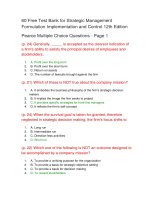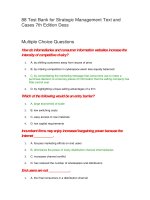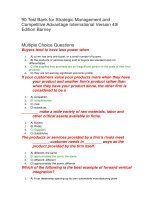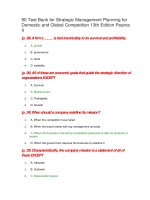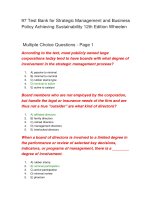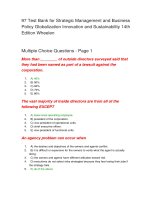90 test bank for strategic management and competitive advantage international version 4th edition barney
Bạn đang xem bản rút gọn của tài liệu. Xem và tải ngay bản đầy đủ của tài liệu tại đây (109.29 KB, 17 trang )
90 Test Bank for Strategic Management and
Competitive Advantage International Version 4th
Edition Barney
Multiple Choice Questions
Buyers tend to have less power when
1.
2.
A) a firm has only one buyer, or a small number of buyers.
B) the products or services being sold to buyers are standard and not
differentiated.
3. C) the supplies they purchase are an insignificant portion of the costs of their final
products.
4. D) they are not earning significant economic profits.
If your customers value your products more when they have
your product and another firm's product rather than
when they have your product alone, the other firm is
considered to be a
1.
2.
3.
4.
A) competitor.
B) complementor.
C) rival.
D) substitute.
________ make a wide variety of raw materials, labor and
other critical assets available to firms.
1.
2.
3.
4.
A) Buyers
B) Rivals
C) Suppliers
D) Substitutes
The products or services provided by a firm's rivals meet
________ customer needs in ________ ways as the
product provided by the firm itself.
1.
2.
3.
4.
A) different; the same
B) approximately the same; the same
C) different; different
D) approximately the same; different
Which of the following is the best example of forward vertical
integration?
1.
A) A car dealership opening up its own automobile manufacturing plant
2.
B) A car company opening its own dealerships to sell its products directly to
customers
3. C) A car company opening its own chain of video rental stores
4. D) A car company opening a plant to product motorcycles
________ valuable assets are resources required to
successfully compete in an industry.
1.
2.
3.
4.
A) Strategically
B) Pedestrian
C) Globally
D) Domestically
Which type of competition is characterized by a small
number of firms, homogeneous products and costly
entry and exit?
1.
2.
3.
4.
A) Perfect competition
B) Monopolistic competition
C) Oligopoly
D) Monopoly
Consolidation strategy is a good option in what type of
industry?
1.
2.
3.
4.
A) Mature
B) Emerging
C) Fragmented
D) Declining
The values, beliefs and norms that guide behavior in society
are known as
1.
2.
3.
4.
A) climate.
B) demographics.
C) economics.
D) culture.
________ costs exist when customers make investments in
order to use a firm's particular products or services.
1.
2.
3.
4.
A) Strategic-switching
B) Competitive-switching
C) Customer-switching
D) Resource-switching
The most promising opportunity for a firm in a declining
industry is to
1.
2.
A) establish itself as a first mover in the post-shakeout industry.
B) become a market leader in the pre-shakeout industry.
3.
4.
C) become a fast follower in the pre-shakeout industry.
D) merge with another firm.
________ are advantages that come to firms that make
important strategic and technological decisions early
in the development of an industry.
1.
2.
3.
4.
A) Visionary advantages
B) First-mover advantages
C) Comparative advantages
D) Missionary advantages
Rivalry tends to be high when
1.
2.
3.
4.
A) there are few firms in an industry and these firms tend to be unequal in size.
B) the industry growth rate is higher.
C) firms are unable to differentiate their products.
D) production capacity can be added in small increments.
Civil wars, political coups, terrorism, wars between
countries, famines, and country or regional economic
recessions are all examples of which element of the
general environment?
1.
2.
3.
4.
A) Demographics
B) Specific international events
C) Economics
D) Culture
Frequent price cutting by firms in an industry, frequent
introduction of new products by firms in an industry
and intense advertising campaigns are indications of
1.
2.
3.
4.
A) high power of buyers.
B) high threat of entry.
C) high levels of rivalry.
D) high threat of substitutes.
The major opportunity facing firms in fragmented industries
is
1.
2.
3.
4.
A) refining their current products and emphasizing an increase in service quality.
B) developing new products and technologies.
C) creating a first-mover advantage through technological leadership.
D) the implementation of strategies that began to consolidate the industry into a
smaller number of firms.
In the S-C-P model, ________ refers to the strategies that
firms in an industry implement.
1.
2.
3.
4.
A) structure
B) strategy
C) conduct
D) performance
Which of the following statements regarding substitutes is
accurate?
1.
A) In the extreme, substitutes can ultimately replace an industry's products or
services.
2. B) Substitutes place a floor on the prices firms in an industry can charge and on
the profits firms in an industry can earn.
3. C) Substitutes rarely impact the profitability that firms in an industry can earn.
4. D) The importance of substitutes in reducing the profit potential in a wide variety of
industries is decreasing.
Firms that have either recently begun operations in an
industry or that threaten to begin operations in an
industry soon are considered to be ________ in the
five forces framework.
1.
2.
3.
4.
A) barriers to entry
B) new entrants
C) suppliers
D) buyers
The ________ consists of broad trends in the context in
which a firm operates that can have an impact on a
firm's strategic choices.
1.
2.
3.
4.
A) micro-environment
B) general environment
C) task environment
D) internal environment
A(n) ________ is any individual, group, or organization
outside a firm that seeks to reduce the level of that
firm's performance.
1.
2.
3.
4.
A) environmental threat
B) environmental opportunity
C) environmental equalizer
D) competitive advantage
Industries in which a large number of small or medium-sized
firms operate and no small set of firms has dominant
market share or creates dominant technologies are
called ________ industries.
1.
2.
3.
4.
A) fragmented
B) mature
C) emerging
D) declining
Firms that engage in a long, systematic phased withdrawal
from an industry, extracting as much value as possible
during the withdrawal period, are following a(n)
________ strategy.
1.
2.
3.
4.
A) niche
B) expansion
C) divestment
D) harvest
________ exist when a firm's cost rise as a function of its
volume of production.
1.
2.
3.
4.
A) Economies of scale
B) Economies of scope
C) Diseconomies of scale
D) Learning cure effects
An industry in which a large number of small or mediumsized firms operate and no small set of firms has
dominant market share or creates dominant
technologies is known as a(n) ________ industry.
1.
2.
3.
4.
A) fragmented
B) consolidated
C) mature
D) emerging
Which type of competition is characterized by a large
number of firms, heterogeneous products and low cost
of entry and exit?
1.
2.
3.
4.
A) Perfect competition
B) Monopolistic competition
C) Oligopoly
D) Monopoly
The products or services provided by a firm's substitutes
meet ________ customer needs in ________ ways as
the product provided by the firm itself.
1.
2.
3.
4.
A) different; the same
B) approximately the same; the same
C) different; different
D) approximately the same; different
Within the five forces framework, the five most common
threats facing firms from their competitive
environment include each of the following except
1.
2.
3.
4.
A) substitutes.
B) complementors.
C) suppliers.
D) buyers.
Mature industries are characterized by
1.
2.
3.
4.
A) an increase in total industry demand.
B) faster increases in production capacity.
C) a slowdown in the introduction of new products or services.
D) a decrease in the amount of international competition.
When activity in an economy is relatively low for a short
period of time, the economy is said to be in a
1.
2.
3.
4.
A) recession.
B) depression.
C) prosperous cycle.
D) boom.
Firms in industries characterized by ________ can expect to
earn only competitive parity.
1.
2.
3.
4.
A) perfect competition
B) monopolistic competition
C) oligopoly
D) monopoly
________ industries are newly created, or newly recreated
industries formed by technological innovations,
changes in demand, or the emergence of new
customer needs.
1.
2.
3.
A) Mature
B) Emerging
C) Fragmented
4.
D) Declining
Overall, the average level of performance in an industry is
likely to be highest when
1.
2.
A) the threat level of all five forces is high.
B) the threat level of rivalry and substitutes is low, but the threat level of suppliers,
buyers and new entrants is high.
3. C) the threat level of rivalry, substitutes and new entrants is high, but the threat
level of buyers and supplies is low.
4. D) the threat level of all five forces is low.
The advantages that come to firms that make important
strategic and technological decisions early in the
development of an industry are known as ________
advantages.
1.
2.
3.
4.
A) first-mover
B) competitive
C) early-entrant
D) first-comer
Which if the following attributes makes suppliers a stronger
threat?
1.
2.
3.
4.
A) The supplier's industry is dominated by a small number of firms.
B) When the product or service provided by suppliers is not highly differentiated
C) When suppliers are threatened by substitutes
D) When suppliers are not able to enter into and begin competing in a firm's
industry
In general, first-mover advantages can arise from any of
these sources except
1.
2.
3.
4.
A) technological leadership.
B) preemption of strategically valuable assets.
C) the creation of customer switching costs.
D) using an imitative strategy to introduce improved versions of competitors' new
products.
All other things being equal, which of the following would
lead to lower barriers to entry in an industry?
1.
2.
3.
4.
A) The existence of economies of scale in the industry
B) Products are highly differentiated in the industry.
C) Industry incumbents have learning-curve cost advantages.
D) Raw materials are widely and readily available at a competitive price.
All of the following are elements of the general environment
except
1.
2.
3.
4.
A) technological trends.
B) demographic trends.
C) industrial trends.
D) cultural trends.
In a perfectly competitive industry,
1.
2.
A) there are relatively few firms operating in the industry.
B) the products and services sold by firms in the industry are very different from
each other.
3. C) it is very costly for firms to enter the industry.
4. D) it is not very costly for firms to exit the industry.
________ is/are the distribution of individuals in a society in
terms of age, sex, marital status, income, ethnicity,
and other personal attributes that may determine
buying patterns.
1.
2.
3.
4.
A) Demographics
B) Economics
C) Technological trends
D) Culture
True - False Questions
The major opportunity facing firms in fragmented industries
is the implementation of strategies that begin to
consolidate the industry into a smaller number of
firms.
1.
2.
True
False
Diseconomies of scale exist in an industry when a firm's
costs fall as a function of that firm's volume of
production.
1.
2.
True
False
The S-C-P model assumes that any competitive advantages a
firm has in an industry must benefit society.
1.
True
2.
False
Learning-curve cost advantages are present when the cost
of production falls with the cumulative volume of
production.
1.
2.
True
False
All divestments are caused by industry decline.
1.
2.
True
False
The threat of entry in an industry depends on the cost of
entry, and the cost of entry, in turn, depends upon the
existence and "height" of barriers to entry.
1.
2.
True
False
A firm's general environment consists of broad trends in the
context within which the firm operates that can have
an impact on the firm's strategic choices.
1.
2.
True
False
A severe recession that lasts for several years is known as a
depression.
1.
2.
True
False
To a firm seeking competitive advantage, an environmental
threat is any individual, group, or organization outside
a firm that seeks to reduce the level of that firm's
performance.
1.
2.
True
False
Suppliers are a greater threat to firms in an industry when
suppliers are threatened by substitutes.
1.
2.
True
False
In general, technological change creates opportunities, but
not threats.
1.
2.
True
False
In an industry, the products or services provided by a firm's
rivals meet approximately the same customer needs in
the same way as the products or services provided by
the firm itself, whereas substitutes meet approximately
the same customer needs but do so in different ways.
1.
2.
True
False
The threat of rivalry tends to be high in an industry when
firms are able to meaningfully differentiate their
products.
1.
2.
True
False
The objective of divestment is to extract a firm from a
declining industry.
1.
2.
True
False
A fragmented industry is an industry that has experienced an
absolute decline in unit sales over a sustained period
of time.
1.
2.
True
False
A firm following a niche strategy in a declining industry
reduces its scope of operations and focuses on
narrow segments of the declining industry.
1.
2.
True
False
Monopolistically competitive industries consist of only a
single firm.
1.
2.
True
False
It is possible for a single firm to be a complementor of one
firm and a competitor of another.
1.
2.
True
False
The threat of buyers is greater if the products or services
that are being sold to buyers are standard and not
differentiated than if the products sold to buyers are
highly differentiated.
1.
2.
True
False
An emerging industry is an industry in which a large number
of small or medium-sized firms operate and no small
set of firms has a dominant market share or creates
dominant technologies.
1.
2.
True
False
If the owner of a jewelry store who normally purchased
diamonds from a diamond brokerage firm were to open
its own diamond brokerage firm, this would be an
example of forward vertical integration.
1.
2.
True
False
Sophisticated software can enhance the value that
customers receive from a personal computer.
Therefore, software can be said to be a complementor
of a personal computer.
1.
2.
True
False
In the structure-conduct-performance model, the term
"structure" refers to industry structure, measured by
such factors as the number of competitors in an
industry.
1.
2.
True
False
Brand identification and customer loyalty serve as entry
barriers because new entrants not only have to absorb
the standard costs associated with starting production
in a new industry, but also have to absorb the costs
associated with overcoming an incumbent firm's
differentiation advantages.
1.
2.
True
False
First movers that invest only in technology usually obtain
sustained competitive advantages, even if they do not
tie up strategically valuable resources in an industry
before their full value is widely understood.
1.
2.
True
False
Culture is the values, beliefs and norms that guide a
behavior in a society, and culture is largely the same
across the world.
1.
2.
True
False
According to Bradenburger and Nalebluff, a firm's
competitors help increase the size of a firm's markets
while complementors divide this market among a set
of firms.
1.
2.
True
False
According to the S-C-P model, attributes of the industry
structure within which a firm operates define the range
of options and constraints facing a firm.
1.
2.
True
False
A firm's supplier poses a greater threat if the supplier's
industry has a large number of firms, none of which
dominate the supplying industry, than if the supplier's
industry is dominated by a small number of firms.
1.
2.
True
False
The five forces framework is based on the S-C-P model and
identifies the five most common threats facing firms
from their local competitive environment and the
conditions under which these threats are more or less
likely to be present.
1.
2.
True
False
Proprietary technology is more important as a barrier to
entry than is managerial know-how.
1.
2.
True
False
Product innovation is an effort to refine and improve a firm's
current processes.
1.
2.
True
False
The aging of the "baby boomer" generation in American
society is an example of a demographic trend.
1.
2.
True
False
In the structure-conduct-performance model, the term
"performance" refers solely to the performance of
individual firms.
1.
2.
True
False
Firms pursuing a harvest strategy in a declining industry do
not expect to remain in the industry over the long
term.
1.
2.
True
False
Mature industries are characterized by elements such as
slowing growth in total industry demand, a slowdown
in increases in product capacity, and an overall
increase in the profitability of firms in the industry.
1.
2.
True
False
Within the five forces framework, when all five threats are
very high competition in the industry begins to
approach a monopoly.
1.
2.
True
False
If you were to purchase a new Apple iPod and were unable to
use your previously downloaded library of digital
music with your new iPod, this would be an example of
a customer-switching cost you would incur to use
Apple's product.
1.
2.
True
False
In a perfectly competitive industry, a large number of firms
have products and services that are similar to each
other and it is not very costly for firms to enter into or
exit these markets.
1.
2.
True
False
In general, it is rarely the case that all five forces in the five
forces framework will be equally threatening at the
same time.
1.
2.
True
False
Free Text Questions
Identify and define the three elements of the S-C-P model.
Answer Given
The three elements of the S-C-P model are structure, which in this model refers to
industry structure, measured by such factors as the number of competitors in an
industry, the heterogeneity of products in an industry, and the cost of entry and exit
in an industry, conduct, which refers to the strategies that firms in an industry
implement and performance, which includes both the performance of individual
firms and the performance of the economy as a whole.
Identify the five most common threats facing firms from their
local competitive environment that are represented in
the five forces framework, and discuss under what
conditions firms in a specific industry are most likely
to earn an above average profit and when they are to
likely to earn a below average profit.
Answer Given
The five threats that constitute the five forces framework include the threat of
entry, the threat of rivalry, the threat of substitutes, the threat of suppliers, and the
threat of buyers. When all five threats are low, competition begins to approach
what economists call a monopoly and firms are able to earn above average profits.
Alternately, when all give forces are very high, competition begins to approach
perfect competition and the best firms can hope to earn is competitive parity.
Identify the six interrelated elements that comprise a firm's
general environment.
Answer Given
The six interrelated elements of a firm's general environment include technological
change, demographic trends, cultural trends, the economic climate, legal and
political conditions and specific international events.
What is a harvest strategy?
Answer Given
In a harvest strategy, which is usually employed in a declining industry, the firm
engages in a long, systematic withdrawal, extracting as much value as possible
during the withdrawal period. This can work if there is some value to harvest.
Identify and clearly distinguish between the four strategic
options available to firms in a declining industry.
Answer Given
The four major strategic options available to firms in a declining industry are
leadership, niche, harvest and divestment. One strategy is for a firm to position
itself to become a market leader in the pre-shakeout industry by becoming the firm
with the largest market share in that industry. The purpose of becoming the marker
leader is to facilitate the exit of firms that are not likely to survive a shakeout. A firm
following a niche strategy in a declining industry reduces its scope of operations
and focuses on narrow segments of the declining industry. Firms pursuing a
harvest strategy engage in a long, systematic, phased withdrawal, extracting as
much value as possible during the withdrawal period. Finally, firms pursuing
divestment extract a firm from the declining industry, but do so soon after a pattern
of decline is established in an industry.
What are customer-switching costs?
Answer Given
Customer-switching costs exist when customers make investments in order to use
a firm's particular products or services. These investments tie customers to a
particular firm and make it more difficult for customers to begin purchasing from
other firms.
Identify the four types of competition, the attributes of each
type and the expected performance under each.
Answer Given
The four types of competition include perfect competition, monopolistic
competition, oligopoly and monopoly. Perfect competition is characterized by a
large number of firms, homogeneous products, low cost entry and exit, and firms
in these industries can expect to earn only competitive parity. Monopolistic
competition is characterized by a large number of firms, heterogeneous products,
low cost entry and exit, and firms in such industries can earn a competitive
advantage. Oligopoly is characterized by a small number of firms, homogeneous
products, and costly entry and exit; firms in such industries can earn a competitive
advantage. Finally, monopoly is characterized by one firm and costly entry. Firms
in such industries can earn a competitive advantage.
Describe the difference between a competitor and a
complementor and identify the role complementors
play in an industry.
Answer Given
A firm is a competitor if your customers value your product less when they have
this other firm's product than when they have your product alone. On the other
hand, another firm is a complementor if your customers value your products more
when they have this other firm's product than when they have your product alone.
It is possible for a firm to be a complementor for some firms and competitors for
others and it is also possible for a single firm to be both a competitor and a
complementor, especially in industries where it is important to create technological
standards.
Identify the four generic industry structures and the specific
strategic opportunities in each of these industries.
Answer Given
The four generic industry structures are fragmented industries, emerging
industries, mature industries, and declining industries. Fragmented industries are
industries in which a large number of small or medium-sized firms operate and no
small set of firms has dominant market share or creates dominant technologies.
The major opportunity facing firms in fragmented industries is the implementation
of strategies that begin to consolidate the industry into smaller firms. Emerging
industries are newly created, or newly recreated industries formed by
technological innovations, changes in demand, and the emergence of new
customer needs. The opportunities that face firms in emerging industries fall into
the general category of first-mover advantages or making important strategic and
technological decisions early in the development of an industry. Industries begin to
enter the mature stage when the rate of innovation in new products and
technologies drops. Opportunities for firms in mature industries focus on a greater
emphasis on refining a firm's current products, on increasing the quality of service,
on reducing manufacturing costs, and on increasing quality through process
innovations. A declining industry is an industry that has experienced an absolute
decline in unit sales over a sustained period of time. The major strategic options
that face firms in this kind of industry are leadership, niche, harvest and
divestment.
Discuss the difference between a company's rivals and its
substitutes and discuss the role substitutes play in an
industry.
Answer Given
The products or services provided by a firm's rivals meet approximately the same
customers' needs in the same ways as the products or services provided by the
firm itself, while substitutes meet approximately the same customers' needs but do
so in different ways. Substitutes place a ceiling on the prices firms in an industry
can charge and on the profits firms in an industry can earn.
